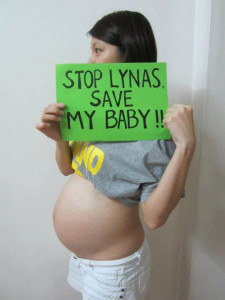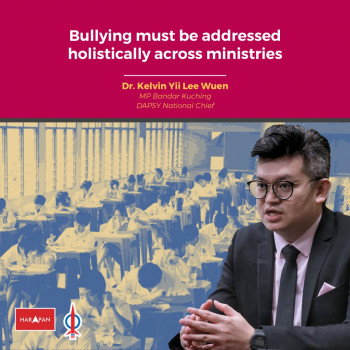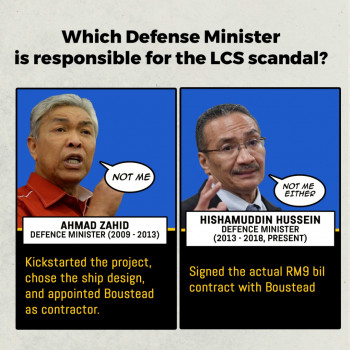by Charles Santiago
While we welcome the report of the Parliamentary Select Committee on Lynas, this is clearly a document which has only looked at ways to keep the Lynas Advance Material Plant in operation.
The key area – returning the radioactive waste to Western Australia – has not been looked at although it was one of the earliest pre-conditions to the government granting Lynas a Temporary Operating License.
Violating pre-requisite to the Temporary Operating License (TOL)
Over a ten-year period of the plant’s operation, the total volume of waste will amount to 2,766,600 cubic metres. Over a 20-year period, as Lynas continues to enjoy its tax break, the waste would presumably have doubled.
And it is highly inconceivable that there will be enough soil and technology available to “dilute” the wastes and remove its radiation level to natural ground level radiation. This is especially crucial as Lynas plans to store the wastes onside in the Residue Storage Facility (RSF).
The PSC recommendation has noted that some of the regulations imposed by the Malaysian government are better than international standards. But according to the Lynas document which is under review, the management of radioactive residue generated from the decommissioning activities of LAMP upon cessation of operations after 20 years are not within the scope of the Lynas Radioactive Waste Management Plan or RWMP but presented in a separate document titled “Decommissioning Plan (Environ 2011b). This is certainly not in tandem with international standards.
Malaysia is still in the midst of cleaning up after the Asian Rare Earth factory was decommissioned at the cost of USD100 million, the largest in the rare earth industry. The rare earth factory was set-up 30 years ago and we are yet to wipe out all traces of residue. Lynas will produce 20,000 tonne of radioactive material, ten times more than the Asian Rare earth.
The managing director for Lynas, Datuk Mashal Ahamd has said that a Permanent Disposal Facility (PDF) will be needed in a worst case scenario where it is unable to reprocess the waste into a commercial product.
“We have 17 years before we even need to identify where is the PDF,.we are working on commercial applications…Once we find all this, we can even forget a Residue Storage Facility,” he said.
Datuk Mashal must be reminded that we are not working on hypothesis or possibilities here because it involves the lives of tens of thousands of people.
Nuclear radiologist Peter Karamoskos of the International Campaign to Abolish Nuclear Weapons said that without exception, thorium reactors have never been commercially viable, nor do any of the intended new designs even remotely seem to be viable. Like all nuclear power production, they rely on extensive taxpayer subsidies. This was reported in The Guardian last June.
Why are we talking about a storage facility in Malaysia when it was made clear that one of the prerequisite to the Temporary Operating License or TOL is that the waste be shipped back to Western Australia.
The Australian government reiterated that it will not accept responsibility for any waste material produced by Lynas, although one of the five conditions attached to the recent approval of its temporary operating license is that it must take full responsibility for waste management from its plant including returning the waste to the source, if necessary.
In an official statement to Free Malaysia Today, the Western Australian Minister for Mines and Petroleum, Norman Moore, asserted that “Australia does not support the importation and storage of other countries’ radioactive waste”.
But in a media briefing, AELB director-general, Raja Abdul Aziz Raja Adnan, gave his assurance that the board would insist on a letter of undertaking from Lynas Australia that it would adhere to this condition.
So where is the consistency in the approach the government has taken in relations to Lynas? It is clear the UMNO-led government is doing everything possible to allow Lynas to start its operations.
MOSTI Minister rejected an appeal by local residents against Lynas’s temporary operating permit on June 15, while imposing extra conditions on the plant. The permit granted in February, subject to conditions, has been held up due to appeals by protesters to government and in court. Lynas Executive Chairman Nicholas Curtis said the plant has passed every review it has subjected to and looks forward to the issuance of the Temporary Operating License.
Without Lynas sending back its waste to be managed in Western Australia, these recommendations are null and void. If its not so, then clearly the government is facilitating the operations of Lynas, despite strong protests and going back on its own guidelines.
While I have repeatedly said this, let me say it again:
Why didn’t Lynas set-up the rare earth plant near its source of extraction in Western Australia as it would have saved a huge amount of money in shipping costs?
2. Why didn’t Lynas obtain an approval from the authorities in Western Australia to set-up the plant?
3. Could the authorities in Western Australia be concerned about the possible radiation leaks, health hazards, birth defects, lead poisoning and other complications?
4. Shouldn’t this in itself raise a red flag with the Malaysian authorities?
5. Is the RM700 million in foreign investment more important to the Malaysian government than the lives of its citizens?
Health over investment?
 The PSC has outlined a guideline to look into health measures for the people, wording it to say that this was undertaken to arrest the fears of the public.
The PSC has outlined a guideline to look into health measures for the people, wording it to say that this was undertaken to arrest the fears of the public.
Severe birth defects, eight leukemia cases over five years in a community of 11,000, tears and anguish of the poor people from a largely shoe-making community – these are not news headlines. Neither is it the plot of a movie.
These are the consequences of carelessly allowing the Asian Rare Earth factory to be built in Bukit Merah, Perak in 1982. When Mitsubishi Chemical started operating its rare earth factory, the villagers complained of choking sensation, pungent smell, coughs and colds.
The community also saw a sharp rise in the cases of infant deaths, congenital disease, leukemia and lead poisoning. Thirty years later, it has not wiped out the memories and heartache of the villagers who lost their children and loved ones. Only the government is feigning ignorance.
According to the Consumer Association of Penang (CAP), the arbitrary classification of radioactive wastes radically differs from the latest International Atomic Energy Agency’s (IAEA) classification of radioactive wastes. It further says the Atomic Energy Licensing Board (AELB) has arbitrarily set its own safety standards for radiation exposure, which is not in accordance with international standards.
The AELB standards would be used to exempt and clear Lynas’ radioactive wastes for reuse and recycle. The exposure to radioactive waste was one of the causes that led to high levels of lead poisoning and other severe health complications of the people in Bukit Merah.
The severe illnesses were detected years after the Asian Rare Earth factory had started its operations. Are we going to repeat this? And what does the panel propose in terms of monitoring the health of the people, screening for potential exposure to radiation, follow-ups, the team of experts who would be at the disposal of the public and also determine who gets screened and tested?
The crushing of ore also releases Radon, which can travel thousands of miles according to wind direction. Does this mean special arrangements would be put in place to monitor all Malaysians?
Without giving much thought to the process of monitoring the health of the people, ruling politicians have jumped on the bandwagon to parrot prime minister Najib’s assurance that the factory is safe.
MITI minister Mustapa Mohamed said its policy would be based on laws, policies and the decision of the AELB. It’s about time the learned minister acknowledges that the lives of millions of people cannot be based on procedures.
I challenge the panel to answer this question – Can everyone of you say, without any doubt, that the Lynas plant poses no health threat to the people? Can you vouch that we would not see another repeat of the health disaster which happened in Bukit Merah?
AELB vs IAEA
The IAEA General Safety Guide rates the clearance dose for individuals as 10 microsieverts (uSv) or lease in a year. The guide also stated that “to take account of the occurrence of low probability events leading to higher radiation exposure, an additional criterion was used, namely the effective does due to such low probability events should not exceed 1mSv in a year…
This is in sharp contrast to the figure stated by Lynas in its Radiological Impact Assessment (RIA) report which states the highest possible does to be received by workers resulting from operation of the plant for the first 10 years are below 13mSv per year. If this is not an admission that the risk of exposure is 10 times more than that permitted under the IAEA regulation, I do not know what is.
Furthermore Radiology and environmental expert Prof Dr Ahmad Termizi Ramli said the general perception was that the high levels of radioactive waste would result in deaths.”The Lynas plant will only produce one millisieverts (mSv) per year as required by law compared with the existing 2.4mSv background radiation already present in the air. Why did the learned Prof not take into account the exposure to the workers in the Lynas plant?
Nuclear physicist Dr Abdul Rahman Omar said the thorium waste which will be produced by Lynas can be used as fuel to generate between RM2 trillion to RM4 trillion worth of electricity a year.
“One tonne of thorium can produce the same amount of energy of 10 million tonnes of coal; imagine the energy that can be harnessed from this,” he is reported to have told the PSC committee.
In a world increasingly aware of and affected by global warming, the news that 2010 was a record year for greenhouse gases levels was something of a blow. And although China, Japan, US and India are pursuing it, the concept of thorium as a source for green energy remains inconclusive. The National Nuclear Laboratory said that the claims for thorium are overstated.
Oliver Tickell, author of Kyoto2, says the fission materials produced from thorium are of a different spectrum to those from uranium-235, but ‘include many dangerous-to-health alpha and beta emitters’.
The dangers of Thorium
Rocks and soil contain natural radioactivity, which also dissolves into ground water. The occurrence of these ‘naturally occurring radioactive materials’ (NORM) varies throughout the world, and may be more or less likely given the types of rocks and minerals in a particular area. NORM contributes a part of the natural ‘background’ exposure from radiation.
When resources are extracted from the earth, the natural radioactive material comes with those resources. In processing the desired resource, the radioactive material is removed and becomes a waste. The radioactive wastes from extraction and processing are called ‘Technologically Enhanced Naturally Occurring Radioactive Material’ (TENORM) because human activity has concentrated the radioactivity or increased the likelihood of exposure by making the radioactive material more accessible to human contact.
In other words, this natural radioactive material has been made dangerous because it was removed from the ground and concentrated by mechanical and chemical processes.
We need to be concerned about TENORM because:
• It has the potential to cause elevated exposure to radiation.
• People may not be aware of TENORM materials and need information about them.
• Industries that generate these materials may need additional guidance to help manage and dispose of them in ways that protect people and the environment and are economically sound.
The most common naturally radioactive elements are uranium, thorium, and radium. Common sources of TENORM waste are mining and mineral processing, oil and gas production, and drinking water and wastewater treatment. The PSC report points out that Lynas is not a nuclear plant or a mining site. However, Lynas is going to extract rare earth from ore. The process of crushing the ore releases Throrium, which is radioactive. But adding a mechanical and chemical process to an existing radioactive material increases the potential risk of exposure.
The final smirk from Lynas
Its rather strange that Lynas enjoyed operating from its premises – getting its structures concretised and putting together its logistics – while the Parliamentary Select Committee was plugging away at its report. It really does not make any sense but rather gave an impression that the recommendations of the committee would have no bearings whatsoever to the plant. Lynas, it seems, almost knew it would not be shut down however damning is the information unearthed by the committee. This is precisely why the opposition felt it was a total waste of time to sit on the panel.
When Malaysia, disregarding once again the strong protests registered by the people, rejected a bid to cancel the Temporary Operating License for Lynas, its share advanced as much as 15 cents (Australian) to A$1.01, the biggest gain since May 28 this year.
But in doing so and allowing Lynas to start its operations, the government has nonchalantly dismissed the value of peoples’ lives which are at stake. -The Rocket






What a load of rubbish this article.
This author has cherry picked facts and mashed them together incoherently.
All of the questions you raised have been answered over and over again. Yet you choose to ignore them and ask the same questions. Why are you so ignorant?
Why didn’t Lynas set-up the rare earth plant near its source of extraction in Western Australia as it would have saved a huge amount of money in shipping costs?
There is no water available for the processing in WA, and it is cheaper to process in Malaysia. Your obviously ignorant because you fail to understand the operational costs, its not about shipping costs. Personell costs is the major consideration as is the tax free operational costs.
2. Why didn’t Lynas obtain an approval from the authorities in Western Australia to set-up the plant?
Lynas did get approval in WA, they also got approval in China, but were invited to setup operation in Malaysia. Based on economics and political uncertainty (in China) they chose Malaysia.
3. Could the authorities in Western Australia be concerned about the possible radiation leaks, health hazards, birth defects, lead poisoning and other complications?
WA is a mining state and they are aware of hazards and risks in all forms of mining. Lynas is not mining lead, what has this got to do with anything? What are “other complications”? Have you ever done a risk assessment before? Do you know what one is and how it is developed?
4. Shouldn’t this in itself raise a red flag with the Malaysian authorities?
No, it shouldnt, because there is nothing wrong with Lynas plant. It has similar risks to petroleum refining which is done in Kuantan already by Petronas. Why target Lynas without targetting Petronas or Siemens, or other toxic waste industries?
5. Is the RM700 million in foreign investment more important to the Malaysian government than the lives of its citizens?
Lives are important, and the LAMP has been proven to be designed safely. With development and investment this will improve the living standard of Malaysians and Malay society will be better off.
Of course all of these answer have been given before but a select few simply chyoose to ignore.
For example one of the SMSL charmen said… ‘Even if the LAMP is found to be safe we will not give up the fight’
This is pure ignorance.